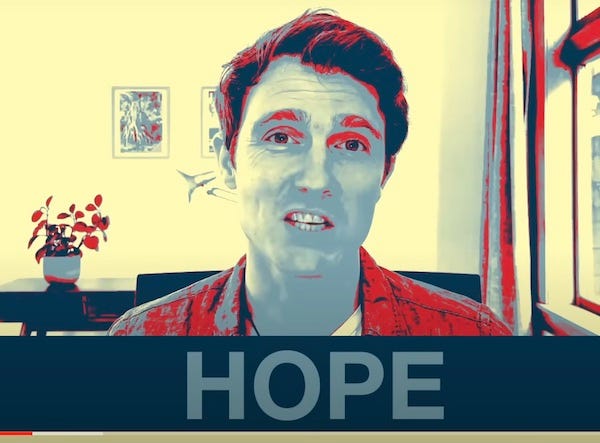April Fuels’ Day 2035: Fossils Seek More ‘Clarity’ Before Investing in Carbon Capture
Fossil execs run out of patience in quest to preserve life as their shareholders know it. Because what's another $10 billion when it's someone else's money?
CALGARY, April 1, 2035 – Canada’s fossil fuel lobby is demanding more “clarity” on the federal government’s intentions before investing its own money in version 13.1 of a proposed $67.5-billion carbon capture and storage hub in the Alberta heartland.
The price tag attached to the industry’s visionary quest to preserve life as they know it has remained relatively steady, all things considered, since fossil execs first offered it up for a mere $24.1 billion in the early 2020s.
“We’re patient, but not that patient,” said Alex Parody, the extremely long-serving éminence grise of the Pathways Alliance, whose six remaining members account for 95% of the hot air, bluster, tailings pond leaks, unpaid municipal taxes, and political campaign contributions from the Alberta oil and gas sector.
“If we don’t get this done, our shareholders are going to freeze in the dark. They know they have no imaginable future without fossil fuels.”
But Parody warned that his industry’s public-spirited generosity had its limits. “We won’t get off our butts until we get more clarity on how taxpayers will keep us swimming in unearned cash until 2100,” he said. “You didn’t really think we were doing this for our health or anyone else’s, did you?”
The Last Fossil Subsidy
The mostly forgotten fossil industry icon was reacting to the 2035-36 federal budget, released days earlier by Finance Minister Steven Guilbeault, which almost marked the end of the country’s last fossil fuel subsidy. The fossil lobby had spent months desperately courting politicians and senior officials, promising a lifetime supply of rainbows and unicorns to anyone who could free up the $50 billion in subsidies that Parody always said he wanted.
Somehow, in a shocking development that no one saw coming, Ottawa resisted the backroom pressure last week, in a budget that left only one last fossil fuel subsidy standing.
Guilbeault—who first entered the federal cabinet as heritage minister in 2019, in an era when fossils still had the country’s political culture in a stranglehold—declared the country’s last remaining funding pool for oil and gas “a sound and timely investment in Canada.”
“When I first ran for office, we’d already spent a decade trying to define ‘inefficient’ fossil fuel subsidies,” he said. “Today, we know the most efficient thing we can do is just pay these people to please stop talking.”
With Guilbeault’s words, a dozen of Canada’s top climate hawks tearfully tendered their resignations after admitting there was nothing left for them to do.
In his fifth annual budget delivered last week, the long-serving federal finance wizard declared his fourth surplus in a row, unveiled a long-awaited basic income guarantee for all Canadians, and officially retired the “net” in net-zero after the last kilowatt-hour of fossil-fuelled electricity was taken off the country’s much-expanded power grid.
Guilbeault also projected that the federal debt would be retired 18 months ahead of schedule, thanks to surging revenue from exports of renewable electricity, green hydrogen that is actually, really green, made-in-Canada energy efficiency equipment—and lots and lots of maple syrup.
A Downhill Slide for Carbon Capture
Parody acknowledged that carbon capture technology has had a rough ride since its peak in 2022. That was when projects completed or under construction looked set to capture an amazing and awe-inspiring 244 million tonnes of carbon dioxide per year, nearly 1% of the carbon pollution humanity spewed into the atmosphere the previous year.
Things went downhill for the industry from there, as the price of solar fell to near-zero, long-duration storage batteries took the guesswork out of utility planning, 90% of Canadians declared themselves unwilling to live anywhere but a 15-minute community, and Generation Dread finally began to get some respect and a bit of control over the country’s economy.
Meanwhile, as no one anywhere, ever had predicted, the cost of carbon capture technology continued to skyrocket.
“Man, those were the days, when the math was simple,” Parody said in a hypothetical interview from the Gusher Retirement Home in Fort McMurray, the museum town and massive solar farm in northern Alberta that was once the beating heart of the country’s most dynamic and forward-looking industry.
“We told those witless bureaucrats in Ottawa they could have a really good deal back in ’22, when we swore we could build this über-cool, 20th-century tech for just $24.1 billion,” Parody grumbled. “Such a bargain. So what if it’s nearly tripled in cost since then? That didn’t stop them when they had a pipeline to build!”
That was a reference to the ill-fated Trans Mountain Pipeline expansion, the fossil fuel megaproject that taxpayers bought at the bargain basement price of $4.5 billion in 2018, only to shut it down three years after completing construction for a mere $45 billion.
“Ya know, people get so excited about a decimal point,” said Canadian banking CEO Stan Stranded, whose institution led financing for Trans Mountain and most of the other big, climate-busting projects the country has abandoned over the last decade.
“A billion here, 10 billion there. It’s no big deal when it’s other people’s money.”
Better Nuclear Than Wind
In the United Kingdom, meanwhile, Extension Cord Rebellion attempted to block access to London Bridge after carefully following the science and concluding that large mountains of radioactive waste from small modular nuclear reactors were less harmful than offshore wind farms believed to be doubling as sanctuaries for endangered marine species.
“We know we can create permanent change if we can get 3.5% of the population out into the streets,” a spokesperson declared. “As long as someone else doesn’t get out a different 3.5% two weeks from now.”
Londoners neatly skirted the bridge barricades on their stylish Oxforder e-bikes, named in honour of the wildly successful 15-minute community initiative now celebrating its 13th year.
And with the United Nations preparing to convene this year’s COP 40 climate summit in mid-December on the sunny shores of Tuktoyaktuk, Northwest Territories, negotiators were hard at work on the 19th iteration of a loss and damage fund for the three small island states that haven’t yet disappeared beneath the rising seas.
“The work program is progressing at the expected pace,” maintained COP 40 President Aramco J. Petronas, the tenth fossil CEO in a row to lead the annual negotiations. “Parties have been having frank exchanges in contact groups to reach an overarching common vision of the mechanisms and modalities to arrive at a framework for constructive dialogue, and the 750 remaining square brackets in the text have been [thoroughly discussed and vetted] [mostly ignored] [multiplying like rabbits]. I hear Tuktoyaktuk is beautiful in the year-round summertime!”
But even with the UN working diligently to prove that some things never change, Canadians began breathing a careful sigh of relief as their energy bills plummeted, the air got cleaner, their daily commutes shortened, and the country’s climate emissions continued to fall.
“It worked. It actually worked,” said Corporate Knights Executive Research Director Ralph Torrie, in an interview from his zero-emission, net-energy-positive, mass-deep-retrofitted home office outside Toronto. “We told them so. Then we told them again. And again. But who knew they would actually listen?”
At the Centre of the Known Universe on Parliament Hill, the staff collective of The Energy Mix gathered at the Eternal Frame, the popular national monument to Canada’s first successful zero-emission wood-frame subdivision, to toast the end of a 26-year publishing run.
“We said we wanted to work ourselves out of a job by 2035,” declared the AI that had written most of the widely-read, thrice-daily e-digest over the last five years. “And thanks to some of the people cited in this pre-emptive piece of fake news, and the legions of others there wasn’t space to acknowledge, we got it done.”
[The rest of the news in this edition of the Energy Mix Weekender is real—Ed.]
Mitchell Beer traces his background in renewable energy and energy efficiency back to 1977, in climate change to 1997. Now he scans 1,200 news headlines a week to pull together The Energy Mix and The Energy Mix Weekender.
You can also bookmark our website for the latest news throughout the week.
Video of the Week








